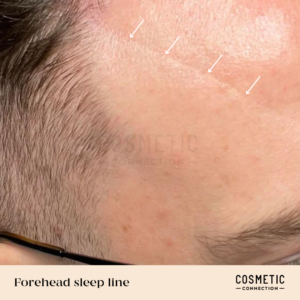Side sleeping may be comfortable, but it is notorious for causing the development of diagonal and vertical wrinkles that run across your face and scalp.
Due to damage that occurs when your skin bunches while side sleeping, they often stand out due to the different orientation in comparison to normal wrinkles.
While avoiding side sleeping is the best way to prevent sleep lines, most side sleepers find back sleeping very difficult. They often wake up on their side unable to recall rolling over.
The good news is that their are treatment options to reduce the appearance of sleep lines and wrinkles.
What are sleep lines?
Sleep lines are the vertical or diagonal wrinkles that develop on your face. Initially faint and temporary, only seen in the morning, over time they become deeper and etched into the skin. Sleep lines are most commonly found on your cheeks, forehead, and around your eyes. But can also develop anywhere on your scalp.

What causes sleep lines?
There are a few things that contribute to the development of sleep lines.
- Pressure and compression: When sleeping, especially on your side, face or stomach, the pressure from your pillow causes your skin to bunch, fold and crease. This is the primary cause of sleep lines.
- Loss of collagen and elasticity: With age your skin weakens, and sleep lines that were once temporary start to last longer. Eventually they become permanently etched into your skin.
- Poor skin quality: If you don’t look after your skin, or suffer with skin dehydration, you are more prone to developing sleep lines.
Are sleep lines permanent?
Initially, sleep lines are temporary, fading in under an hour. However, over time as your skin ages, sleep lines can become a permanent problem.
Can sleep lines be prevented?
The only way to prevent sleep lines is to avoid sleeping on your stomach and sides. This stops your skin bunching and folding, meaning sleep lines won’t develop.
If you cannot sleep on your back, there are a few ways to slow down the development of sleep lines.
- Use a silk or satin pillowcase, which reduces friction compared to cotton. This helps to reduce skin creasing while you sleep.
- Skin care that focusses on hydration can make your skin more resilient, and less prone to forming sleep lines.
Book your consultation now
Best treatments for sleep lines?
There are a range of convenient treatments to reduce the appearance of sleep lines. Most work by adding skin structure and support to the areas prone to creasing. A consultation with a professional is essential for assessing suitability.
If you’re concerned about the appearance of sleep lines, and looking to learn more about your options, contact us for a consultation.

